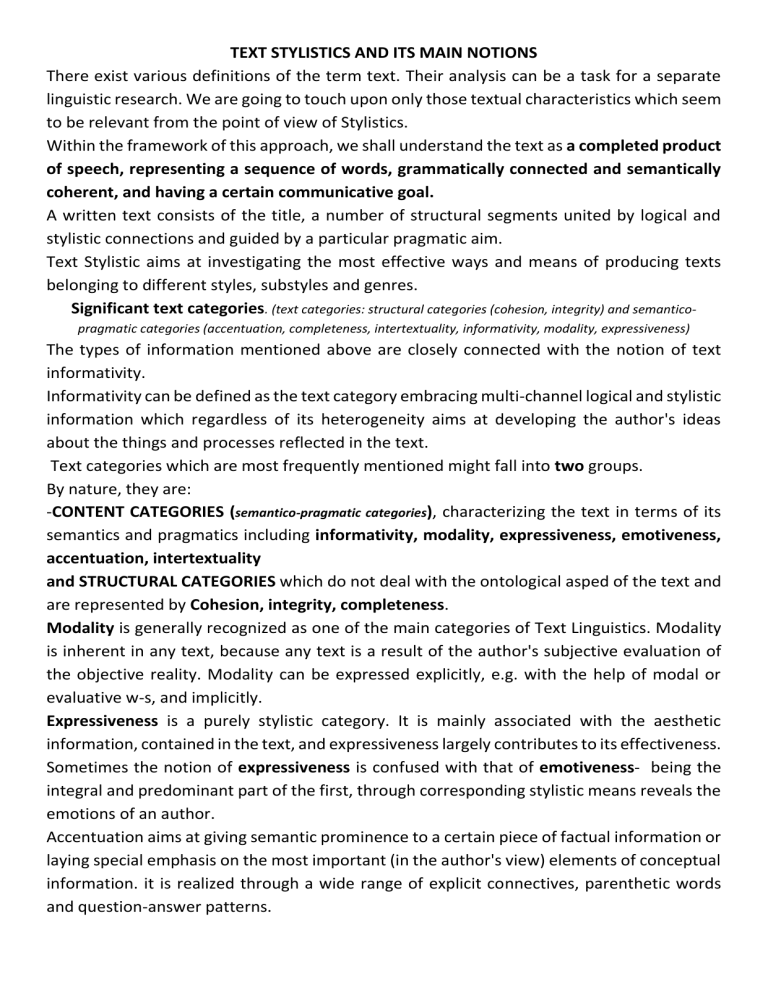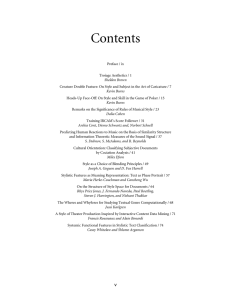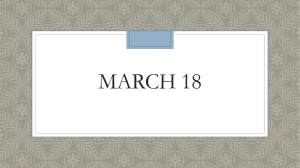
TEXT STYLISTICS AND ITS MAIN NOTIONS There exist various definitions of the term text. Their analysis can be a task for a separate linguistic research. We are going to touch upon only those textual characteristics which seem to be relevant from the point of view of Stylistics. Within the framework of this approach, we shall understand the text as a completed product of speech, representing a sequence of words, grammatically connected and semantically coherent, and having a certain communicative goal. A written text consists of the title, a number of structural segments united by logical and stylistic connections and guided by a particular pragmatic aim. Text Stylistic aims at investigating the most effective ways and means of producing texts belonging to different styles, substyles and genres. Significant text categories. (text categories: structural categories (cohesion, integrity) and semanticopragmatic categories (accentuation, completeness, intertextuality, informativity, modality, expressiveness) The types of information mentioned above are closely connected with the notion of text informativity. Informativity can be defined as the text category embracing multi-channel logical and stylistic information which regardless of its heterogeneity aims at developing the author's ideas about the things and processes reflected in the text. Text categories which are most frequently mentioned might fall into two groups. By nature, they are: -CONTENT CATEGORIES (semantico-pragmatic categories), characterizing the text in terms of its semantics and pragmatics including informativity, modality, expressiveness, emotiveness, accentuation, intertextuality and STRUCTURAL CATEGORIES which do not deal with the ontological asped of the text and are represented by Cohesion, integrity, completeness. Modality is generally recognized as one of the main categories of Text Linguistics. Modality is inherent in any text, because any text is a result of the author's subjective evaluation of the objective reality. Modality can be expressed explicitly, e.g. with the help of modal or evaluative w-s, and implicitly. Expressiveness is a purely stylistic category. It is mainly associated with the aesthetic information, contained in the text, and expressiveness largely contributes to its effectiveness. Sometimes the notion of expressiveness is confused with that of emotiveness- being the integral and predominant part of the first, through corresponding stylistic means reveals the emotions of an author. Accentuation aims at giving semantic prominence to a certain piece of factual information or laying special emphasis on the most important (in the author's view) elements of conceptual information. it is realized through a wide range of explicit connectives, parenthetic words and question-answer patterns. Intertextuality is one more important content category closely connected with the notion of subtext and understanding the text itself as the dialogue going on between the author and the reader during the process of their communication. A subtext can be created with the help of citations, allusions, reminiscences, and other sorts of inclusions. Cohesion can be understood in two ways - as formal cohesion or content cohesion. The latter is often referred to as coherence and is associated with a logically consistent development of the main theme. External cohesion is actually realized by means of dif types of formal links: • connectors e.g. and, but, , moreover • transitions e.g. accordingly, find then, again, • pronouns e.g. '.his, , those, his, .her, its', • lexical and synonymic repetitions including the distant word repetition; • developed antithesis; • sustained, or prolonged, metaphor; • parallel constructions through which the reader is led back to the ideas phrased in similar syntactical forms. Integrity and completeness are considered to be those categories which make the text different from a non-text. Completeness of the text can be understood as the result of the integrity of its constituent units. And it is up to the author to decide where "to put a full slop". Doing so, he demonstrates that the message has been conveyed and his/her part of the dialogue with the reader has been completed. Paragraphs, larger passages and chapters, often have their own topics or themes. But this independence is relative since structural components of a separate text are not isolated segments. To be understood properly they require the broader context they belong to. TYPES OF INFORMATION A written text consists of the title, a number of structural segments united by logical and stylistic connections and guided by a particular pragmatic aim. The main types of textual information The logical elements of the text correlate with reality, the style-forming elements correlate with the addressee of textual information. Taking into account I.R.Galperin's point of view, one can speak about three types: Factual information - data about people, things, and events existing in real or fictitious worlds. It is always explicit. It is also supposed to be logical and objective by character. Conceptual information reflects the author's individual understanding of the relationships among the people and events described. It is derived from the text by the reader himself/herself and in tin's respect can be subjective. Subtextual information is a kind of implicit information stylistic by its nature. This additional information can appear in the text as a result of interaction and simultaneous realization of different types of lexical and structural meanings. Associatrve and connotative meanings, accompanying direct meanings of language units, constitute the basis of implication. Texts belonging to certain functional styles, especially the belles-letters style, can possess the so-called aesthetic Information which can be created on the basis of all the three types of content information singled out by I.R.Galperin. THE BASIC TEXTUAL SEGMENT Heated discussions on what is to be recognized as the basic textual segment are still going on. In one view, it should be nothing else but a supra-phrasal unit. The representatives of Communicative Grammar use this term to denote a passage of the text larger than a sentence. It expresses only one definite thought and can be extracted from the context without losing a relative semantic independence of its own. The practical problem is that supra-phrasal units are not clearly perceived in most types of texts. One of the main compositional units facilitating the reader’s perception of the utterance is a paragraph, since it graphically reflects the logic and emotional structure of the semantic unit while reading a paragraph is marked out by a specially prolonged disjunctive pause. The pause and the structure of the paragraph perform important textual-stylistic functions: they help to place accents, create the composition of the text, reflect and make noticeable the principles of selecting-language material and the degree of its completeness. A paragraph is a syntactico-intonational unity of a higher range than a sentence. Moreover, they often coincide with paragraphs also competing for the role of basic textual segment. Indeed, written discourse graphically falls into paragraphs. Each paragraph can be treated as a unit of thought. Most paragraphs consist of two parts: • the thesis usually contained in the topic, or key, sentence; • the supporting details revolving around this main idea and expanding on it. Thus, the segmentation of the text into chapters in. this case focuses the reader’s attention on the most important spans of the text, compels him to- halt and ponder over the significance of this or that element. TYPES OF CONTEXT According to Amosova context is called a combination with its indicator which stays in direct or indirect connection with actualized word. Under the indicator we mean indicating minimum which let us say surely what of many possible meanings of a polysemantic word is meant here. Under the situation we mean extra-lingual conditions which also perform a function of indicating the meaning of the word (life and textual situations). A direct showing is included in a life situation. An essential component of the theory of stylistic context is a theory of strong position: putting important moments in a strong position in such place in the text where they are psychologically noticeable. Linguistic context is a combination of a linguistic unit with its indicator having an immediate or mediated syntactical connection with the actualized word. It makes the meaning of the unit clear and unambiguous. An extralingual (situational) context is formed by extralingual conditions in which communication takes place. Besides making the meaning of words well-defined, a situational context allows the speaker to economize on speech efforts and to avoid situationally rebundant language signs. Extralingual context can be physical or abstract and can significantly affect the communication. A conversation between lovers can be affected by surroundings in terms of music, location. Such surroundings form a physical context. A dialogue between colleagues can be affected by the nature of their relationships. That is, one may be of higher status than the other. Such nature forms an abstract context. Historical accounts are more easily understood when evoked in the context of their own time. Such context is called temporal or chronological. Stylistic context – unity of stylistic element and its surroundings. Stylistic context: - may be based on the similarity of equivalent words or their contrast - is very often based on the converenge; converenge denotes an accumulation at a given point of the text or several stylistic devices; each device adds its expressivity (e.g. and heaved, and heaved, still unrestingly heaved the black sea, as if its vast tides were a conscience. – simile, repetition, inversion and polysyndation). According to size: Microcontext is the context of a single utterance (sentence). Macrocontext is the context of a paragraph in a text. Megacontext is the context of a book chapter, a story or the whole book. DIFFERENTIATE BETWEEN TEXT, DISCOURSE AND FUNCTIONAL STYLE TEXT is a completed product of speech, representing a sequence of words, grammatically connected and semantically coherent, and having a certain communicative goal. DISCOURSE is defined as a complex communicative phenomenon, which includes, besides the text itself, other factors of interaction, such as shared knowledge, communicative goals, cognitive systems of participants, their cultural competence, etc., i.e. all that is necessary for successful production and adequate interpretation(comprehension and translation) of the text. I.R.Galperin gives the following definition of the functional style: A FUNCTIONAL STYLE is a patterned variety of literary text characterised by the greater or lesser typification of its constituents, supra-phrasal units (SPU), in which the choice and arrangement of independent and interwoven language media are calculated to secure the purport of the communication.


